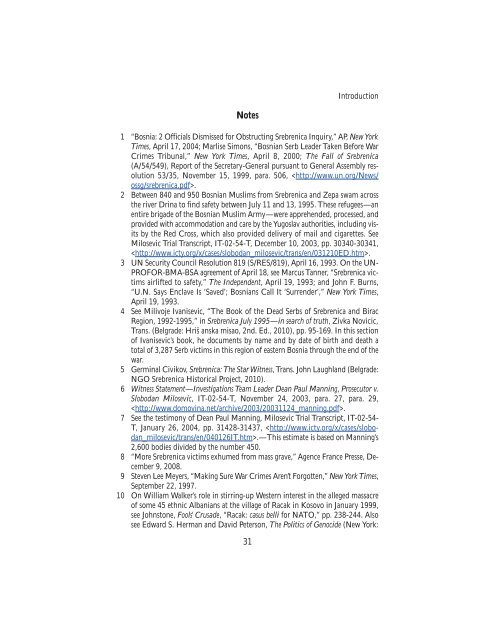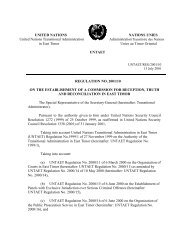The Srebrenica Massacre - Nova Srpska Politicka Misao
The Srebrenica Massacre - Nova Srpska Politicka Misao
The Srebrenica Massacre - Nova Srpska Politicka Misao
Create successful ePaper yourself
Turn your PDF publications into a flip-book with our unique Google optimized e-Paper software.
Notes<br />
Introduction<br />
1 “Bosnia: 2 Officials Dismissed for Obstructing <strong>Srebrenica</strong> Inquiry,” AP, New York<br />
Times, April 17, 2004; Marlise Simons, “Bosnian Serb Leader Taken Before War<br />
Crimes Tribunal,” New York Times, April 8, 2000; <strong>The</strong> Fall of <strong>Srebrenica</strong><br />
(A/54/549), Report of the Secretary-General pursuant to General Assembly resolution<br />
53/35, November 15, 1999, para. 506, .<br />
2 Between 840 and 950 Bosnian Muslims from <strong>Srebrenica</strong> and Zepa swam across<br />
the river Drina to find safety between July 11 and 13, 1995. <strong>The</strong>se refugees—an<br />
entire brigade of the Bosnian Muslim Army—were apprehended, processed, and<br />
provided with accommodation and care by the Yugoslav authorities, including visits<br />
by the Red Cross, which also provided delivery of mail and cigarettes. See<br />
Milosevic Trial Transcript, IT-02-54-T, December 10, 2003, pp. 30340-30341,<br />
.<br />
3 UN Security Council Resolution 819 (S/RES/819), April 16, 1993. On the UN-<br />
PROFOR-BMA-BSA agreement of April 18, see Marcus Tanner, “<strong>Srebrenica</strong> victims<br />
airlifted to safety,” <strong>The</strong> Independent, April 19, 1993; and John F. Burns,<br />
“U.N. Says Enclave Is ‘Saved’; Bosnians Call It ‘Surrender’,” New York Times,<br />
April 19, 1993.<br />
4 See Milivoje Ivanisevic, “<strong>The</strong> Book of the Dead Serbs of <strong>Srebrenica</strong> and Birac<br />
Region, 1992-1995,” in <strong>Srebrenica</strong> July 1995—in search of truth, Zivka Novicic,<br />
Trans. (Belgrade: Hriš anska misao, 2nd. Ed., 2010), pp. 95-169. In this section<br />
of Ivanisevic’s book, he documents by name and by date of birth and death a<br />
total of 3,287 Serb victims in this region of eastern Bosnia through the end of the<br />
war.<br />
5 Germinal Civikov, <strong>Srebrenica</strong>: <strong>The</strong> Star Witness, Trans. John Laughland (Belgrade:<br />
NGO <strong>Srebrenica</strong> Historical Project, 2010).<br />
6 Witness Statement—Investigations Team Leader Dean Paul Manning, Prosecutor v.<br />
Slobodan Milosevic, IT-02-54-T, November 24, 2003, para. 27, para. 29,<br />
.<br />
7 See the testimony of Dean Paul Manning, Milosevic Trial Transcript, IT-02-54-<br />
T, January 26, 2004, pp. 31428-31437, .—This<br />
estimate is based on Manning’s<br />
2,600 bodies divided by the number 450.<br />
8 “More <strong>Srebrenica</strong> victims exhumed from mass grave,” Agence France Presse, December<br />
9, 2008.<br />
9 Steven Lee Meyers, “Making Sure War Crimes Aren’t Forgotten,” New York Times,<br />
September 22, 1997.<br />
10 On William Walker’s role in stirring-up Western interest in the alleged massacre<br />
of some 45 ethnic Albanians at the village of Racak in Kosovo in January 1999,<br />
see Johnstone, Fools’ Crusade, “Racak: casus belli for NATO,” pp. 238-244. Also<br />
see Edward S. Herman and David Peterson, <strong>The</strong> Politics of Genocide (New York:<br />
31



